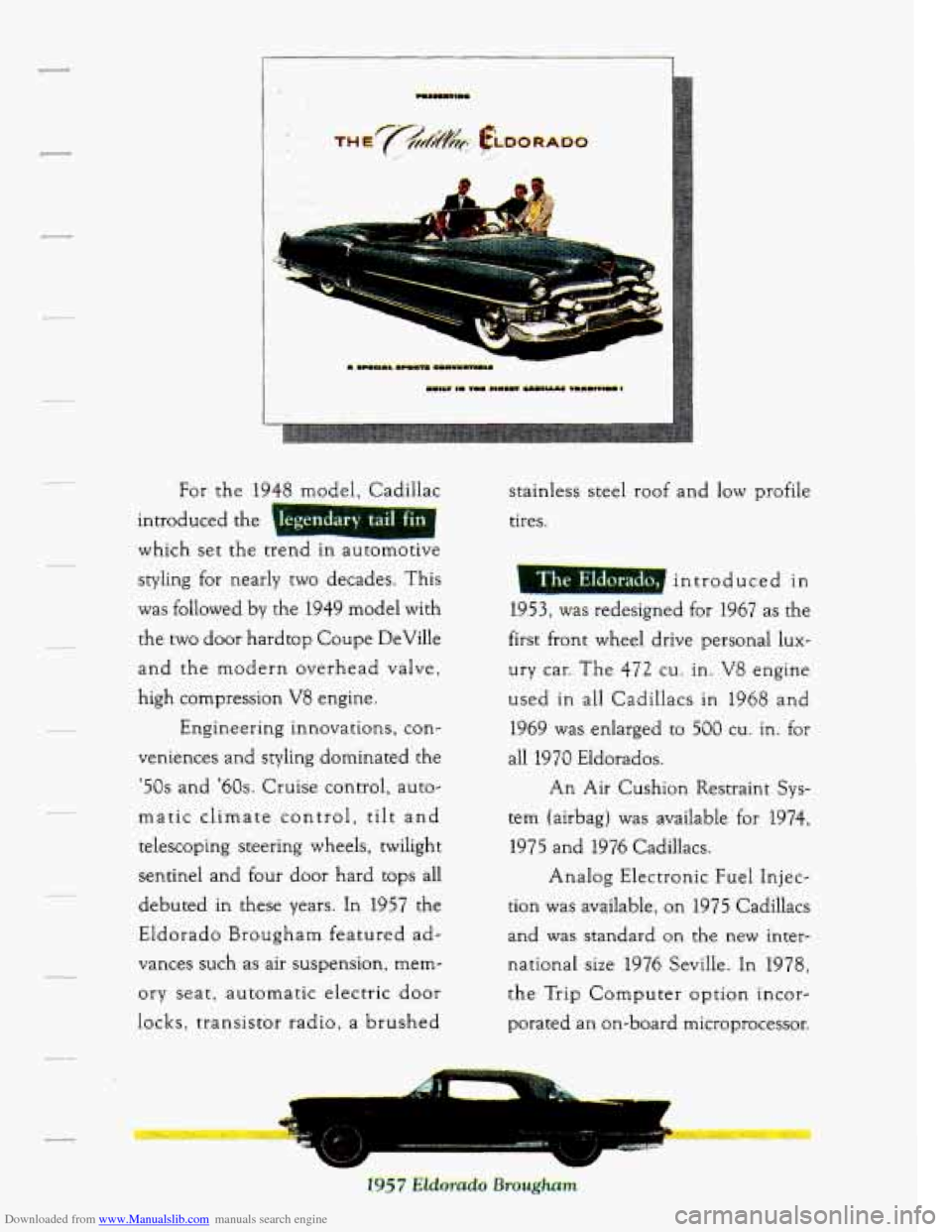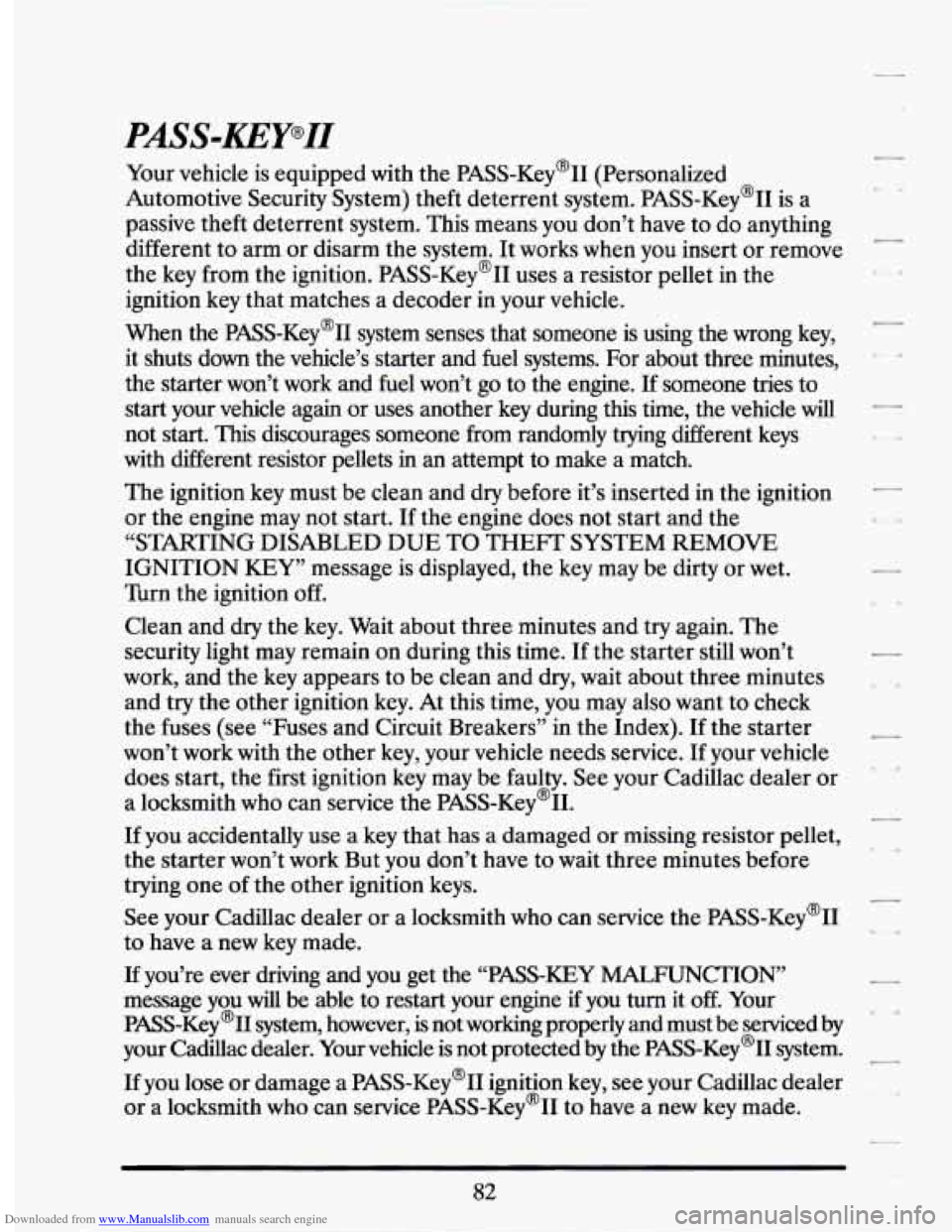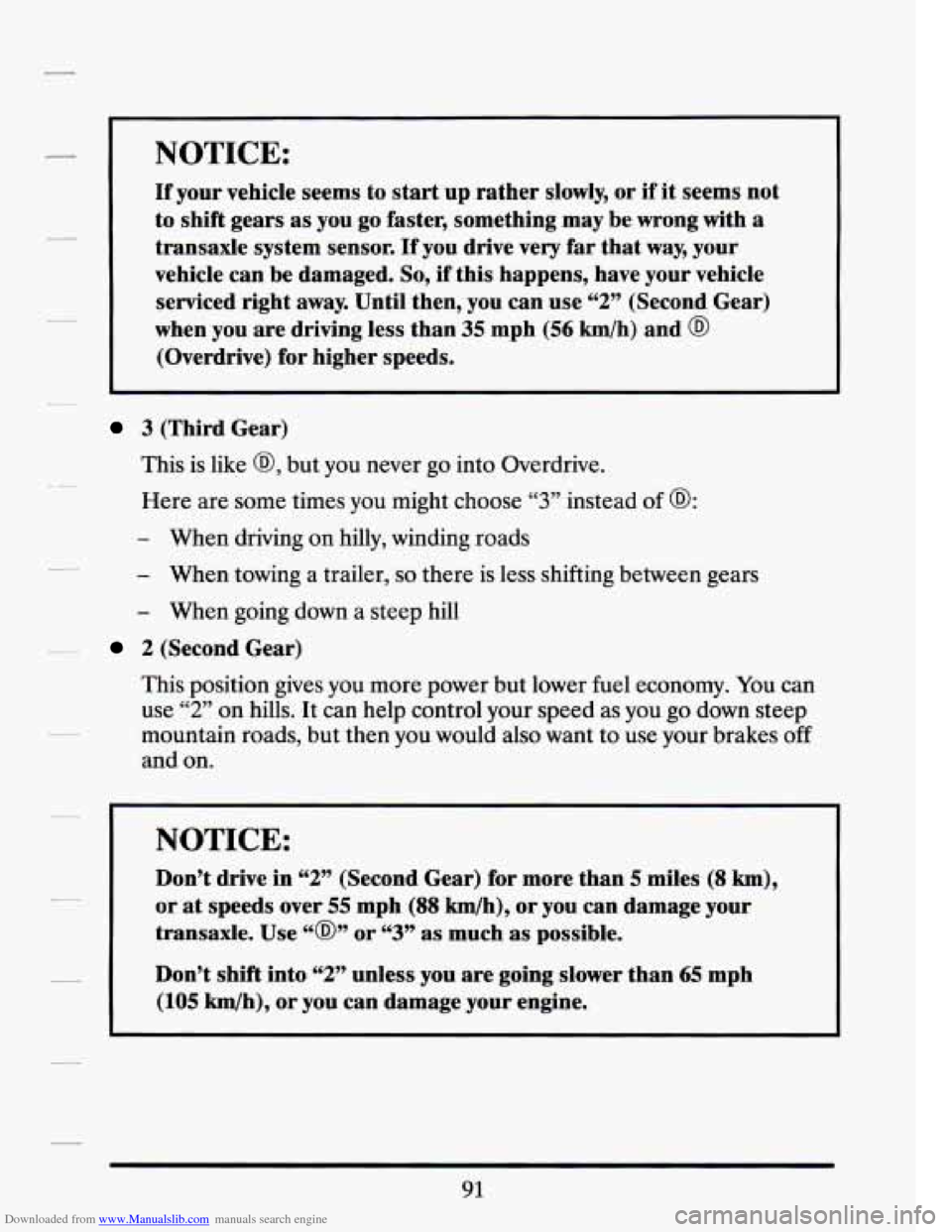Page 8 of 399

Downloaded from www.Manualslib.com manuals search engine -
I
-
introduced the 1 I
which set the trend In automotlve
egendary tail fin
styling for nearly two decades. This
was followed
by the 1949 model with
the two door hardtop Coupe DeVille
and the modern overhead valve,
high compression
V8 engine.
Engineering innovations, con-
veniences and styling dominated the
'50s and '60s. Cruise control, auto-
matic climate control,
tilt and
telescoping steering wheels, twilight
sentine1 and four door hard tops all
debuted in these years. In 1957 the
Eldorado Brougham featured
ad-
vances such as air suspension, mem-
ory seat, automatic electric door
locks, transistor radio, a brushed stainless steel roof and
low profile
tires.
introduced
in
1953,was redesigned for 1967 as the
first front wheel drive personal lux-
ury car. The
472 cu. in. V8 engine
used in
all Cadillacs in 1968 and
1969 was enlarged to
500 cu. in. for
all 1970 Eldorados.
An Air Cushion Restraint Sys-
tem (airbag) was available for
1974,
1975 and 1976 Cadillacs.
Analog Electronic Fuel Injec-
tion was available, on 1975 Cadillacs
and
was standard on the new inter-
national size 1976 Seville. In 1978,
the Trip Computer option incor-
porated an on-board microprocessor.
Page 95 of 399

Downloaded from www.Manualslib.com manuals search engine PASS-KEY’II
Your vehicle is equipped with the PASS-Key’II (Personalized
Automotive Security System) theft deterrent system. PASS-Key’II is a
passive theft deterrent system. This means you don’t have to do anything
different to arm or disarm the system. It works when you insert or remove
the key from the ignition. PASS-Key@II uses a resistor pellet in the
I*
ignition key that matches a decoder in your vehicle.
-
When the PASS-Key’II system senses that someone is using the wrong key,
it shuts down the vehicle’s starter and fuel systems. For about three minutes,
the starter won’t work and fuel won’t
go to the engine. If someone tries to
start your vehicle again or uses another key during this time, the vehicle
will
not start. This discourages someone from randomly trying differe\
nt keys
with different resistor pellets
in an attempt to make a match.
The ignition key must be clean and dry before it’s inserted in the ignition
or the engine may not start. If the engine does not start and the
“STARTING DISABLED DUE TO THEFT SYSTEM REMOVE
IGNITION
KEY” message is displayed, the key may be dirty or wet.
Turn the ignition off.
Clean and dry the key. Wait about three minutes and try again. The
security light may remain on during this time.
If the starter still won’t
work, and the
key appears to be clean and dry, wait about three minutes
and
try the other ignition key. At this time, you may also want to check
the fuses (see “Fuses and Circuit Breakers” in the Index).
If the starter
won’t work with the other key, your vehicle needs service. If your vehicle
does start, the first ignition
key may be faulty. See your Cadillac dealer or
a locksmith who can service the PASS-Key’II.
If you accidentally use a key that has a damaged or missing resistor pellet,
the starter won’t work But you don’t have to wait three minutes before
trying one of the other ignition keys.
See your Cadillac dealer or a locksmith who can service the PASS-Key’II
to have a new key made.
If you’re ever driving and you get the “PASS-KEY MALFUNCTION’ -
message you will be able to restart your engine if you turn it off. Your
PASS-Key’II system, however,
is not working properly and must be serviced by
your Cadillac dealer. Your vehicle is not protected by the PASS-Key’II system.
-
If you lose or damage a PASS-Key@II ignition key, see your Cadillac dealer -
or a locksmith who can service PASS-Key’II to have a new key made.
82
Page 99 of 399

Downloaded from www.Manualslib.com manuals search engine NOTICE:
Your engine is designed to work with the electronics in your
vehicle.
If you add electrical parts or accessories, you could
change the
way the fuel injection system operates. Before
adding electrical equipment, check with your dealer.
If you
don’t, your engine might not perform properly.
If you ever have to have your vehicle towed, see the part of this
Manual that tells how to do it without damaging your vehicle.
See “Towing Your Vehicle” in the Index.
ENGINE COOLANT HEATER (ENGINE
BLOCK HEATER) (CANADA ONLY)
(OPTION)
In very cold weather, 0°F (-18O C) or colder, the engine coolant warmer
can help. You’ll get easier starting and better fuel economy during engine
warm-up. Usually, the coolant warmer should be plugged in a minimum
of four hours prior to starting your vehicle.
To use the coolant warmer:
1. Turn off the engine.
2. Open the hood and unwrap the electrical cord.
3. Plug it into a normal, grounded 110-volt outlet.
-
t. *
Page 104 of 399

Downloaded from www.Manualslib.com manuals search engine NOTICE:
If your vehicle seems to start up rather slowly, or if it seems not
to shift gears
as you go faster, something may be wrong with a
transaxle system sensor. If you drive very far that way, your
vehicle can be damaged.
So, if this happens, have your vehicle
serviced right
away. Until then, you can use “2” (Second Gear)
when you
are driving less than 35 mph (56 km/h) and @
(Overdrive) for higher speeds.
3 (Third Gear)
This is like
@, but you never go into Overdrive.
Here are some times
you might choose “3” instead of 0:
- When driving on hilly, winding roads
- When towing a trailer, so there is less shifting between gears
- When going down a steep hill
2 (Second Gear)
This position gives
you more power but lower fuel economy. You can
use
“2” on hills. It can help control your speed as you go down steep
mountain roads, but then you would also want to use your brakes
off
and on.
NOTICE:
Don’t drive in “2” (Second Gear) for more than 5 miles (8 km),
or at speeds over 55 mph (88 km/h), or you can damage your
transaxle. Use
“@” or “3” as much as possible.
Don’t shift into
“2” unless you are going slower than 65 mph
(105 km/h), or you can damage your engine.
I
91
Page 105 of 399
Downloaded from www.Manualslib.com manuals search engine 1 (First Gear)
This position gives you even more power (but lower fuel economy)
than
“2.” You can use it on very steep hills, or in deep snow or mud. If
the selector lever is put in “1,” the transaxle won’t shift into first gear
until the vehicle is going slowly enough.
NOTICE:
If your front wheels can’t rotate, don’t try to drive. This might
happen
if you were stuck in very deep sand or mud or were up
against
a solid object. You could damage your transaxle.
I-
l-
Also, if you stop when going uphill, don’t hold your vehicle there
with only the accelerator pedal. This could overheat and
damage the transaxle. Use your brakes to hold your vehicle in
position on
a hill.
I
I --
PARKlNG BRAKE
To set the parking brake:
Hold the regular brake pedal
down with your right foot. Push down the
parking brake pedal with your left foot.
If the ignition is on, the brake
system warning light will
come on.
92
Page 143 of 399
Downloaded from www.Manualslib.com manuals search engine THE INSTRUMENT PANEL: YOUR
INFOIWMTION SYSTEM
Your instrument panel is designed to let you know at a glance how your
Cadillac
is running. You’ll know how fast you’re going, how much fuel\
you’re using, and many
of the other things you’ll need to know to drive
safely and economically.
Digital Cluster
Analog Cluster
130
Page 145 of 399
Downloaded from www.Manualslib.com manuals search engine EnglishlMetric Button
You can go back and
forth from English
(miles) to metric
(kilometers) by pushing
this button.
The same button also makes other readings (like temperature, fuel and
odometer) go between English and metric.
Trip Odometer
You can tell how far
you’ve gone since you
last set it back to zero.
To reset, push and hold
the button until it
zeros.
If your vehicle is domestic, the trip odometer will return to zero after
999.9 miles (1609
km). If your vehicle is Canadian or Export, the trip
odometer will return to zero after 1999.9 km (1242 miles).
Page 149 of 399
Downloaded from www.Manualslib.com manuals search engine Engine Temperature Warning Light (Canadian !Export
Only)
This light tells you that
your engine has
overheated. You
should stop the car and
turn the engine off
as
soon as possible. A
warning chime should
also sound
if this light
comes on.
As a check,
the light should come
on for
a few seconds
when
you start your
engine.
HOT COOLANT CAN BURN YOU BADLY!
In “Problems
on the Road,” this manual shows what to do. See “Engine
Overheating” in the Index.
Malfunction Indicator Lamp
i t W1 3VICE .,
ENGINE
SOON
SERVICE
ENGINE SOON
A computer monitors operation of your fuel, ignition and emission
control systems. This light should come on when the ignition is
on, but
136